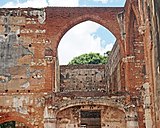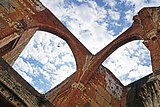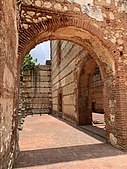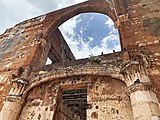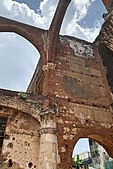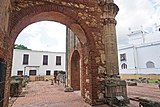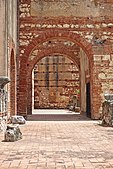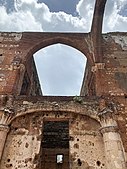Hospital San Nicolás de Bari
The Hospital San Nicolás de Bari is a preserved hospital ruin, and it was recognized by the UNESCO for being the oldest hospital built in the Americas.[1][2] Construction began in 1503[3] in Santo Domingo, Dominican Republic, at the behest of governor (and namesake of the hospital) Nicolás de Ovando. This grand project was in keeping with the desire to emulate European princely courts, and looked to Renaissance Italy for inspiration.[4] At the time of its completion, the wards could accommodate up to 70 patients, comparable to the most advanced churches of Rome.[5] It is likely that the model for the Hospital de San Nicolás was the large Ospedale di Santo Spirito in Sassia in Rome.[6] The complex forms part of the Colonial Zone of Santo Domingo World Heritage Site.
| Hospital San Nicolás de Bari | |
|---|---|
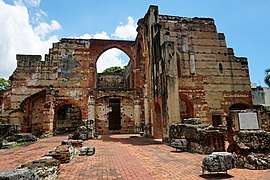 Hospital San Nicolás de Bari | |
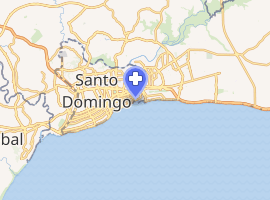
| |
| Geography | |
| Location | Santo Domingo, the Dominican Republic |
| Coordinates | 18.475210°N 69.885540°W |
| Organisation | |
| Type | General |
| Religious affiliation | Catholic church |
| Services | |
| Beds | 70 |
| History | |
| Construction started | 1503 |
| Opened | 1522 |
| Closed | mid-18th century |
| Links | |
| Lists | Hospitals in the Dominican Republic |
History
The hospital began operating in 1522 and provided its services until the mid-18th century.[3]
The complex occupied most of the block and was built on two stories in a cross shaped plan. Each of the corners contained a courtyard that provided light, ventilation, and open space to the various hospital facilities. The structure, in keeping with contemporary European hospitals, was composed of three naves: a central one for worship flanked by two lateral naves which housed the sick. In this way, patients were literally steps away from the sanctuary and the chapel located in its core. There was also a separate private chapel, now incorporated into the adjacent 20th Century Basílica Catedral Nuestra Señora de la Altagracia. This despite the hospital having been undertaken by an association of benefactors rather than by a monastic order.[3]
Already a ruin in 1908 when part of its façade collapsed, the hospital exhibited a combination of Gothic and Renaissance elements, with some considerable Mudéjar influence, as was typical of 16th Century Santo Domingo buildings. For example, the interior arches—which supported Gothic rib vaults—were pointed on the second story yet barreled on the ground floor. The vanguardist plan of the San Nicolás de Bari hospital served as a model for other hospitals throughout Spanish America, namely the Hospital de la Concepción undertaken in Mexico by Hernando Cortés in 1524.[7]
See also
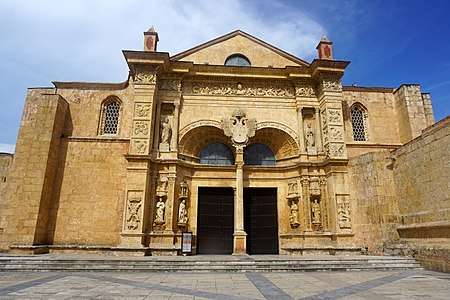
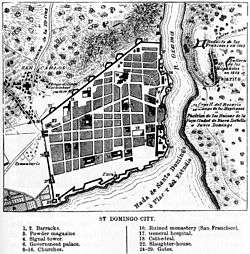
- List of oldest buildings in the Americas
- Some of the other historical sites from the Colonial Era in Santo Domingo's Ciudad Colonial:
- Fortaleza Ozama (built in 1502)
- Basilica Cathedral of Santa María la Menor (construction began in 1512)
- Autonomous University of Santo Domingo (seminary established in 1538)
- Monasterio de San Francisco (built between 1509 and 1560)
Gallery
References
- "Colonial City of Santo Domingo. Outstanding Universal Value". UNESCO World Heritage Centre. Archived from the original on January 4, 2020. Retrieved July 5, 2020.
- "Ruinas del Hospital San Nicolás de Barí". Lonely Planet. Archived from the original on May 1, 2020. Retrieved July 5, 2020.
- "Ruinas del hospital de San Nicolás de Bari, Santo Domingo". visitarepublicadominicana.org. Archived from the original on 2019-09-27. Retrieved 2019-09-27.
- Bailey, Galvin Alexander (2005). Art of Colonial Latin America. New York: Phaidon Press. p. 133. ISBN 0714841579.
- Palm, Erwin Walter (1955). Los Monumentos Arquitectónicos de La Española, Con una introducción a América. 2 vols. Ciudad Trujillo: Universidad de Santo Domingo.
- Bailey, p. 132
- Bailey, p. 133
|
